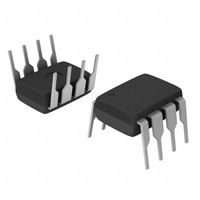1. 物料型号:
- 型号为FAN7527B,由Fairchild Semiconductor生产。
2. 器件简介:
- FAN7527B是一款用于功率因数校正(Power Factor Correction, PFC)的控制器,优化用于电子镇流器和低功耗、高密度电源供应器,这些应用要求最小的板卡尺寸、减少外部组件和低功耗。
3. 引脚分配:
- 1号引脚(INV):错误放大器的反相输入端,BOOST转换器的输出应分压至2.5V并连接至此引脚。
- 2号引脚(EA OUT):错误放大器的输出端,在此引脚和INV引脚之间放置反馈补偿网络。
- 3号引脚(MULT):乘法器阶段的输入端,全波整流交流电压分压至小于2V并连接至此引脚。
- 4号引脚(CS):PWM比较器的输入端,通过电阻感测MOSFET电流,得到的电压应用于此引脚,内部包含R/C滤波器以排除高频噪声。
- 5号引脚(Idet):零电流检测输入端。
- 6号引脚(GND):所有引脚的地电位。
- 7号引脚(OUT):栅极驱动输出端,推挽输出级能够以500mA的峰值电流驱动功率MOSFET。
- 8号引脚(Vcc):驱动和控制电路的供电电压。
4. 参数特性:
- 供电电压:Vcc为30V。
- 峰值驱动输出电流:IOH, IOL为+500mA。
- 驱动输出钳位二极管Vo > Vcc或Vo < -0.3V时的Iclamp为±10mA。
- 检测钳位二极管的Idet为±10mA。
- 错误放大器、乘法器和比较器输入电压Vin为-0.3至6V。
- 工作结温Tj为150°C。
- 工作温度范围Topr为-25至125°C。
- 存储温度范围Tstg为-65至150°C。
- 8-DIP的功耗Pd为1.1W,8-SOP的功耗为0.8W。
5. 功能详解:
- FAN7527B提供简单且高性能的主动功率因数校正,优化用于电子镇流器和低功耗、高密度电源供应器,这些应用要求最小的板卡尺寸、减少外部组件和低功耗。由于R/C滤波器包含在电流感测块中,因此不需要外部R/C滤波器。还增加了特殊电路以防止无负载运行条件。无论供电电压如何,输出驱动钳位电路限制了功率MOSFET门驱动的过冲,大大提高了系统的可靠性。
6. 应用信息:
- 应用于电子镇流器和SMPS(开关模式电源供应器)。
7. 封装信息:
- 提供8-Pin DIP和8-Pin SOP两种封装方式。
